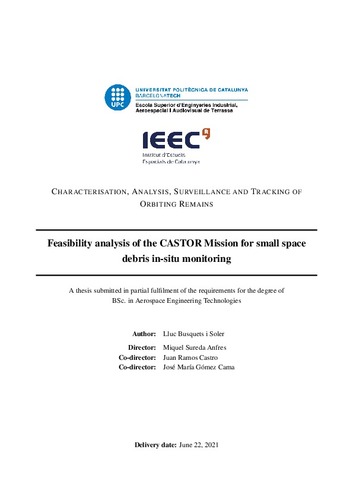Mostra el registre d'ítem simple
Feasibility study of the CASTOR Mission for small space debris in situ monitoring
| dc.contributor | Sureda Anfres, Miquel |
| dc.contributor | Ramos Castro, Juan José |
| dc.contributor | Gómez Cama, José María |
| dc.contributor.author | Busquets Soler, Lluc-Ramon |
| dc.contributor.other | Universitat Politècnica de Catalunya. Departament de Física |
| dc.date.accessioned | 2022-01-24T15:08:00Z |
| dc.date.available | 2022-01-24T15:08:00Z |
| dc.date.issued | 2021-06-22 |
| dc.identifier.uri | http://hdl.handle.net/2117/360519 |
| dc.description.abstract | Aquest treball presenta l'estudi numèric de viabilitat de l'arquitectura de missió proposada per l'equip 4DCube de l'IEEC per a monitorització in situ de fragments petits de brossa espacial (<10 cm) des de nanosatèl·lits. L'estudi ha desenvolupat una simulació de l'òrbita dels satèl·lits juntament amb les d'una població generada de vora 700k objectes, i ha conclòs que el nombre esperat de deteccions és de l'ordre de 100k a l'any. La població s'ha generat per a ajustar-se a les estimacions de densitat d'objectes d'entre 1 i 10 cm segons el model MASTER de l'ESA, i l'algoritme de generació ha estat discutit i confirmat amb enginyers de l'Oficina de Brossa Espacial de la mateixa agència. La simulació ha estat escrita en llenguatge C utilitzant OpenMPI per a permetre'n la paral·lelització, i ha estat executada en un clúster de 32 nuclis de l'ICCUB. Els resultats suggereixen que, considerant la incertesa deguda a la tècnica de la paral·laxi, una determinació d'òrbita preliminar precisa és viable, almenys, per a alguns milers d'objectes a l'any. En aquest sentit, s'ha proposat una generalització del mètode de Herrick-Gibbs, per a determinació d'òrbita preliminar amb qualsevol conjunt de 2n+1 observacions, i els resultats suggereixen que podria ser un ordre més precís que el promitjat de les formulacions clàssiques dels mètodes de Herrick-Gibbs i de Lambert-Gauss respecte el nombre d'observacions consecutives. A més a més, algunes tècniques senzilles de classificació basades en Machine Learning com l'algoritme KNN permeten predir la precisió esperada en la determinació d'òrbites amb taxes d'encert superiors al 95%. |
| dc.description.abstract | This thesis presents the numerical feasibility study of the mission architecture proposed by IEEC's 4DCube team for small space debris (<10 cm) in-situ monitoring from nanosatellites. The study has developed a simulation of the satellites' orbits together with a generated population of 700k debris objects, and concluded that the number of annual detections is expected to be in the order of 100k objects. The population has been generated to be compliant with the density estimations of debris in the 1-10 cm size range according to ESA's MASTER model, and the generation algorithm has been discussed with and confirmed by ESA's Space Debris Office engineers. The simulation has been written in C language using OpenMPI to allow parallelisation, and run in a 32-core cluster at ICCUB. The results suggest that, after considering the uncertainty due to the parallax technique, accurate preliminary orbit determination would be feasible for a few thousand objects per year. In this regard, a generalisation of the Herrick-Gibbs method for preliminary orbit determination valid for any set of 2n+1 observations has been proposed, and the results suggest that it may be accurate by a greater order of magnitude than the averaged classical formulation of the Herrick-Gibbs and Lambert-Gauss methods with respect to the number of consecutive observations. Also, simple classification techniques based on Machine Learning such as the KNN algorithm are able to predict the expected accuracy in the orbit determination with the only information of the observation parameters, with accuracies over 95%. |
| dc.language.iso | eng |
| dc.publisher | Universitat Politècnica de Catalunya |
| dc.rights | Attribution-NonCommercial 3.0 Spain |
| dc.rights.uri | http://creativecommons.org/licenses/by-nc/3.0/es/ |
| dc.subject | Àrees temàtiques de la UPC::Aeronàutica i espai |
| dc.subject.lcsh | Space debris |
| dc.subject.lcsh | Orbital mechanics |
| dc.subject.lcsh | Artificial satellites |
| dc.subject.other | Brossa espacial |
| dc.subject.other | Institut d'Estudis Espacials de Catalunya |
| dc.subject.other | IEEC |
| dc.subject.other | Space debris |
| dc.subject.other | Nanosatèl·lits |
| dc.subject.other | Nanosats |
| dc.subject.other | Cubesats |
| dc.subject.other | Mecànica orbital |
| dc.subject.other | Orbital mechanics |
| dc.title | Feasibility study of the CASTOR Mission for small space debris in situ monitoring |
| dc.type | Bachelor thesis |
| dc.subject.lemac | Residus espacials |
| dc.subject.lemac | Mecànica orbital |
| dc.subject.lemac | Satèl·lits artificials |
| dc.identifier.slug | PRISMA-160444 |
| dc.rights.access | Open Access |
| dc.date.updated | 2021-08-18T18:55:37Z |
| dc.audience.educationlevel | Grau |
| dc.audience.mediator | Escola Superior d'Enginyeries Industrial, Aeroespacial i Audiovisual de Terrassa |
| dc.audience.degree | GRAU EN ENGINYERIA EN TECNOLOGIES AEROESPACIALS (Pla 2010) |





